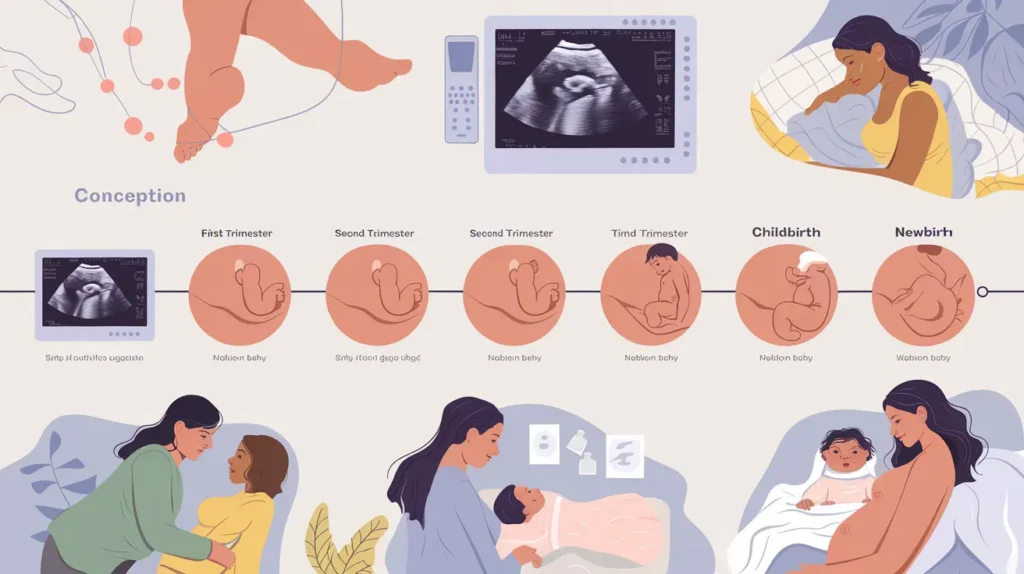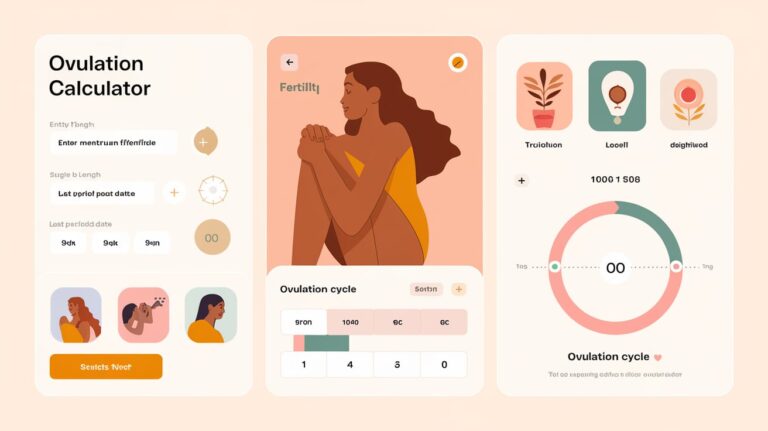
Conception Calculator
Fertility Tips
Comprehensive Guide to Using This Conception Calculator
A conception calculator is an invaluable tool for couples trying to conceive. It helps identify the most fertile days in a woman’s menstrual cycle, thereby optimizing the chances of pregnancy. This guide explains how to use a conception calculator effectively, the science behind it, and additional insights into fertility.
How Does Our Conception Calculator Work?
The conception calculator uses data from your menstrual cycle to predict ovulation and identify your fertile window. Here’s how it works:
- Input Last Menstrual Period (LMP): Enter the date of the first day of your last period.
- Select Cycle Length: Choose your average menstrual cycle length, typically between 21 and 35 days.
- Calculate Ovulation: The calculator predicts ovulation, which usually occurs about 14 days before your next expected period.
- Identify Fertile Window: The tool marks a 6-day fertile window, including the five days leading up to ovulation and the day of ovulation itself.
Example on How To Figure Out Conception Date By Calculations
Calculation
| Last Menstrual Period | Cycle Length | Estimated Ovulation Day | Fertile Window |
|---|---|---|---|
| June 1 | 28 days | June 15 | June 10 to June 15 |
| June 1 | 30 days | June 16 | June 11 to June 16 |
| June 1 | 26 days | June 13 | June 8 to June 13 |
Understanding Conception and Pregnancy

Conception is the process that marks the beginning of pregnancy, occurring when a sperm fertilizes an egg. This complex journey involves several stages, from ovulation to implantation, and is crucial for the development of a new life. This guide provides an overview of conception, the stages of pregnancy, and important factors that influence fertility.
Checkout our menstruation period calculator for estimation of ovulation and menstruation date.
Key Features
- User-Friendly Interface: Most calculators are designed for ease of use, requiring minimal input for immediate results.
- Scientific Backing: Developed using the latest research in reproductive health, ensuring reliable predictions.
Factors Affecting Accuracy
While conception calculators are useful, their accuracy can vary based on several factors:
- Regularity of Menstrual Cycles: Regular cycles enhance prediction accuracy. Irregular cycles can lead to less reliable estimates.
- Cycle Length Variability: Significant variations in cycle length can affect ovulation predictions.
- Health Conditions: Conditions like polycystic ovary syndrome (PCOS) may complicate predictions due to hormonal imbalances.
The Process of Conception
Conception involves a series of steps that must occur for pregnancy to take place:
- Ovulation: Approximately 14 days before your next menstrual period, an ovary releases a mature egg into the fallopian tube.
- Fertilization: If sperm is present in the fallopian tube, it can fertilize the egg within 24 hours after ovulation. At this moment, the genetic material from both parents combines to form a zygote.
- Cell Division: The zygote begins to divide and develop as it travels down the fallopian tube toward the uterus over the next 3 to 5 days.
- Implantation: Once it reaches the uterus, the developing embryo (now called a blastocyst) implants itself into the uterine lining. This is where it will continue to grow and develop into a fetus.
Key Statistics
- Egg Viability: An egg remains viable for about 12 to 24 hours post-ovulation.
- Sperm Lifespan: Sperm can survive in the female reproductive tract for up to 5 days, allowing for conception even if intercourse occurs several days before ovulation.
Stages of Pregnancy

Pregnancy is typically divided into three trimesters, each marked by significant developmental milestones:
First Trimester (Weeks 1-12)
- Weeks 1-2: The first two weeks are counted from the first day of your last menstrual period (LMP), even though conception occurs later.
- Week 3: Fertilization occurs, and the zygote begins its journey to the uterus.
- Week 4: Implantation takes place; pregnancy hormones start to rise, leading to early symptoms like fatigue and nausea.
Second Trimester (Weeks 13-26)
- By this stage, many women experience relief from early pregnancy symptoms.
- The fetus grows rapidly; by week 20, it may weigh about 10 ounces and be about 6.5 inches long.
- Major organs continue to develop, and distinct features become visible through ultrasound.
Third Trimester (Weeks 27-40)
- The fetus continues to grow and gain weight; by week 36, it may weigh around 6 pounds or more.
- The body prepares for labor; positioning changes as the fetus moves into a head-down position.
Fetal Development Overview
| Stage | Duration | Key Developments |
|---|---|---|
| Germinal Stage | Weeks 1-2 | Fertilization and implantation |
| Embryonic Stage | Weeks 3-8 | Major organs and structures begin to form |
| Fetal Stage | Weeks 9-birth | Rapid growth; all organ systems mature |
Factors Influencing Conception
Several factors can affect your ability to conceive, In summary they include:
- Age: Fertility generally declines with age, particularly after age 35 for women due to decreased egg quality and quantity.
- Health Conditions: Conditions such as polycystic ovary syndrome (PCOS), endometriosis, or uterine abnormalities can impact fertility.
- Lifestyle Choices: Smoking, excessive alcohol consumption, poor diet, and lack of exercise can negatively affect fertility in both men and women.
Tips for Improving Fertility
- Maintain a healthy weight through balanced nutrition and regular exercise.
- Avoid smoking and limit alcohol intake.
- Manage stress through relaxation techniques such as yoga or meditation.
- Consider tracking ovulation using methods like basal body temperature or ovulation predictor kits.
Benefits of Using a Conception Calculator

Using a conception calculator offers several advantages:
- Increased Awareness: Helps you understand your menstrual cycle and identify patterns.
- Optimized Timing: Enables couples to plan intercourse during their most fertile days, increasing the chances of conception.
- Personalized Insights: Provides tailored recommendations based on individual cycle data.
Frequently Asked Questions
How Do I Calculate My Fertile Window?
To calculate your fertile window, first determine your menstrual cycle length. The average cycle ranges from 21 to 35 days. Subtract 14 days from the end of your current cycle to estimate ovulation. For optimal results, plan intercourse one to two days before your estimated ovulation date.
Can I Use a Conception Calculator If My Cycles Are Irregular?
Yes, you can still use a conception calculator as a general guide. However, keep in mind that irregular cycles may lead to less accurate predictions. Tracking additional signs of ovulation, such as changes in cervical mucus or basal body temperature, can provide more insights.
What Is the Best Time of Day to Use an Ovulation Test?
For optimal results with an ovulation test, it’s best to test in the afternoon or early evening when hormone levels are typically at their peak after being concentrated in urine throughout the day.
How Long Can Sperm Live Inside the Female Body?
Sperm can survive inside the female reproductive tract for up to 5 days, making it possible to conceive from intercourse that occurs several days before ovulation.
Are There Any Lifestyle Changes That Can Improve My Chances of Conception?
Yes, maintaining a healthy weight, eating a balanced diet rich in fruits and vegetables, reducing alcohol and caffeine intake, and managing stress through relaxation techniques can all enhance fertility for both partners.




